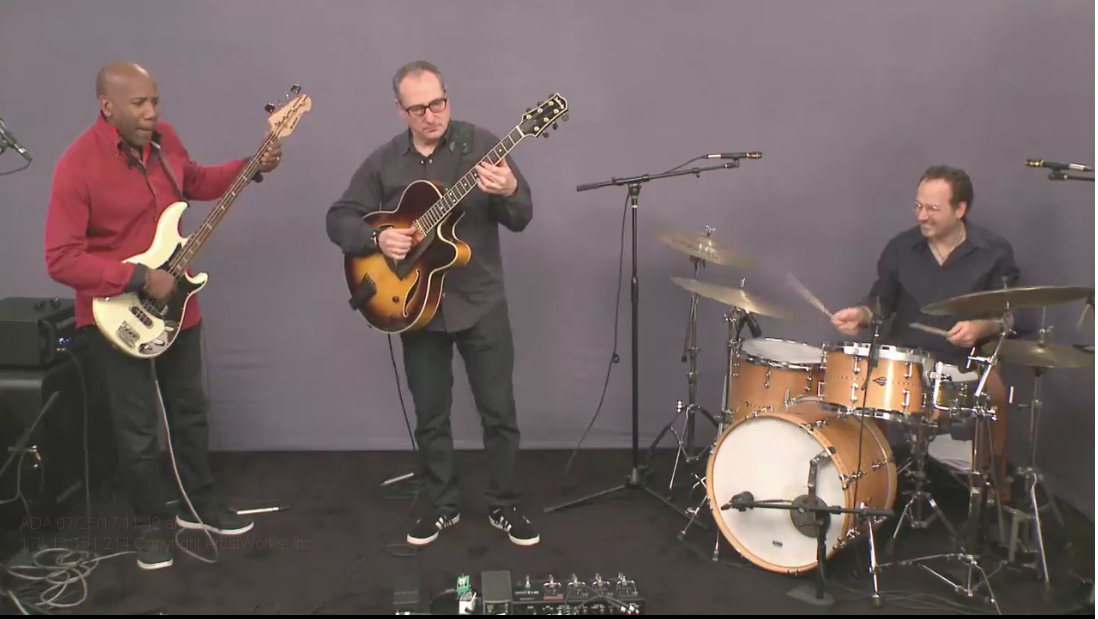The Best Jazz Chord Progressions to Practice

Are you looking for a way to break out of the familiar patterns guitarists can't seem to escape from? Perhaps you’ve already mastered some blues and rock scales but just can’t seem to incorporate that elusive jazzy sound into your guitar playing without it all running off the rails.
While there are no shortcuts to make you sound like Wes Montgomery or Joe Pass, there are some simple jazz chord progressions that will point you in the right direction. So with that in mind, here are some of the main jazz chord progressions that you'll need to know to in order to sail through almost any jazz standard.
New Lessons: Quickstart Guide to Jazz Piano

There's a new section to look out for in the Learning area that's designed for beginner players: "Quickstart Guide to Jazz Piano". If you're new to playing jazz, this is the best place to start. It's a series of seven lessons, here's what's covered:
1. Introduction
George explains how he can make jazz accessible to anyone by providing a path that teaches you how to get started improvising.
2. Our First Tool: The Pentatonic Scale
George teaches the first tool to improvisational freedom in a very simple scale. He starts by framing the stylistic difference of jazz to other styles of piano before getting you started learning a collection of "can't miss" notes. Over a backing track he demonstrates how this scale sounds in context and gives examples on how to start using it to break into the world of improv on your own. Backing tracks in 3 tempos are provided to aid your practice and experimentation.
3. Time & Feel
In this lesson George breaks down the subtlety of going beyond just thinking about the notes choices you make, but exploring how you play them to get them to sound like great jazz. You'll learn how to get that authentic jazz feel from your phrasing, and how to work with timing to add importance to the notes you want to stand out in your phrases. Backing tracks in 3 tempos are provided to aid your practice and experimentation.
4. Expanding on Our First Tool
George expands on the Pentatonic Scale: why it works, and how to think about the note relationships that are happening depending on the chords you play over. He also breaks down different contexts this works in and teaches an exercise to help you remember these concepts.
5. Practice Exercises Using Our First Tool
In this lesson George runs through a series of practice exercise patterns over a slow backing track to help you continue to intuit how this all works. He also shows you how to break out of predicable patterns to start phrasing and making it sound like jazz.
6. Bringing in the Left Hand
George expands on how to fill out the sound with some left hand comping to add harmony. He breaks down the concept of using guide tones to inform how to make note choices and where to place them in relation to the beat. Using a backing track to demonstrate, he then teaches some very simple left hand chords to get you started making great jazz harmonies combining both hands.
7. Taking the Next Steps
Final thoughts on what was covered in this lesson series and a review of the key takeaway points. These concepts are a fantastic first step to being able to improvise freely and comfortably with a great jazz feel. After going through these you'll be on your way to becoming a jazz piano master (or at least ready for Levels 1-5 of the curriculum).
Jazz Guitar Modes: Mastering the Dorian Scale

One thing any aspiring jazz guitarist should know is how to play in different modes. Playing modes isn’t too different from playing the pentatonic scale — there are only two extra notes. However, where those notes go varies from mode to mode.
It is highly recommended that you understand and have practiced the positions and patterns associated with the pentatonic scale and have also covered the basic major and minor scales, as the different modes have a close relationship with these scales. One of the most closely related modes to the major scale is the Dorian mode.
The Dorian mode uses the same pattern of intervals as the major scale (also known as the Ionian mode), but starts at the second note of its relative major. For example, D-Dorian uses the same notes with the same intervals as in C-major, but starts and ends on D rather than C.
So why is this distinction important? If you’re using the same notes, why treat D-Dorian any differently from C-major?
ArtistWorks Live: Talking Jazz with John Patitucci
In this month’s episode of ArtistWorks Live, we were talking with our jazz bass teacher John Patitucci. He’s always up to something and it was interesting to learn more about his experiences as a professional musician. We had some great questions coming in, thanks to everyone who participated!
As always, we send out links to these in advance to our 12 month members so can tune in ask whatever questions they have. It's always different, but always fun. Check it out, and see below for links to more episodes of ArtistWorks Live!






